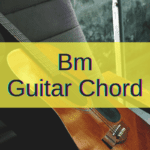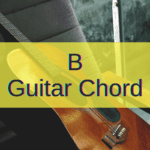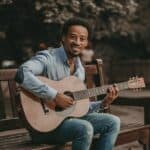Barre chords, when you are a beginner, seem like the final frontier. Yes, they can be considered the guitarist equivalent of becoming a Jedi Knight.
Master the barre chords you must and dominate the fretboard you will. (Imagine that line in a Yoda-meets-Billy-Gibbons voice).
Jokes aside, they take a long while to master and, in the beginning, are rather painful. That being said, though, they are among the most useful chords in history.
Yes, barre chords are a shortcut to playing the most common chords anywhere on the fretboard easily.
So are power chords, a simplified, two-string version of them; that’s why most of us gravitate toward them at the beginning.
The most common barre chord alternatives are power chords. Yet, they won’t let you play minor and seventh chords. Not-so-common alternatives include half-barre chords with a root note on the first string and chords derived from D major with a root note on the fourth string.
I have a confession to make: I was once on the dark side too. This means I was trying to replace barre chords with power chords.
Then, when I tried to make things more interesting with other flavors, I found out they could only take me so far.
So, I cheated.
Yes, when I was learning barre chords myself (over 20 years ago) I created some shapes to play them without the painful part.
I have mixed feelings because I’m proud of finding that shortcut but I know I was a cheater for it.
Nevertheless, here I am, passing on that information to you.
Are you ready to find the not-so-common alternatives to the most common barre chords easily and effortlessly?
Get your lightsaber, I mean guitar because here we go!
Can You Just Not Ever Play a Barre Chord Again?
The answer to the above question is definitely yes.
That being said, the best guitar player in the world is the guitar player that has the most resources and knows when and how to use them.
Moreover, with time and enough practice, barre chords will become just another resource that you can choose to use or not.
What do I mean by this? Very simply, you can avoid barre chords all your life playing other shapes but you’ll be missing a very important color in your palette.
Yes, barre chords have a distinct sound that has been recorded a million times in music history.
Therefore, you might come across a situation in which you want to recreate the sound of a specific song that was played with barre chords originally.
At that moment, you can choose to work your way around it and make it sound different or learn to play barre chords properly and make it sound just like the original.
So, although it is possible not to play a barre chord ever again in your life, it will turn you into a less resourceful guitar player.
Furthermore, it is like putting a ceiling on your possibilities and talent.
Most Common Barre Chords on Guitar and Easier Alternatives
Do you know what barre chords are and why they are so relevant to play music on your guitar? Well, before we go into the alternatives, let’s talk a little about what barre chords are.
To begin the explanation, let’s take a quick look at some of the most common open chords on your guitar.
In this example, we’re basing our explanations on the E and A chords.
These are the three most common shapes of the E chord:
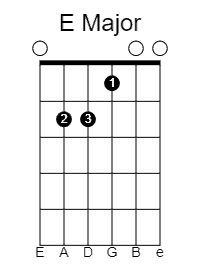


Well, these chords share the same root note: the open E string (your low E or sixth string). What if we move that root note around the fretboard while we maintain the shapes?
You got it; we create different chords with different root notes!
Hence, your index finger forming the barre of the barre chord acts as the nut in your guitar playing open chords.
Therefore, by knowing these simple shapes you can play major, minor, and 7th chords easily around the fretboard.
For example, we can create a G major, a G minor, and a G7 using these same shapes in barre chords.


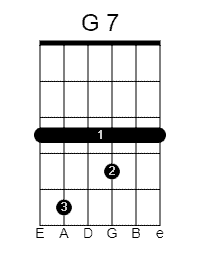
The same thing happens with the 5th string but taking the A chord as a basis:

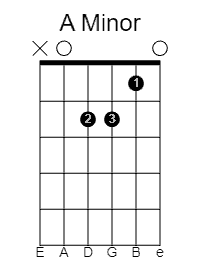

These shapes can easily be turned into:

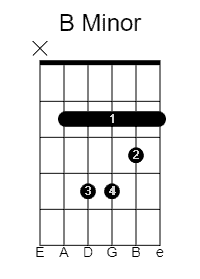

Ok, so we know what barre chords are and why they are great to create chord shapes around the fretboard, but, where is the shortcut to avoid the barre chord?
We’re going right into it in a moment, young Padawan.
So, the easiest way to do this is by using the bottom four strings to create our shapes and then moving them around changing the root note to create the different chords.
The Half-Barre Chord Alternative
These are what I call the half-barre chords and are great to train the barre-chord hand slowly into the six strings.
Major Chords
First, let’s take a look at the Major chords in three root notes: E (open), F, and G.


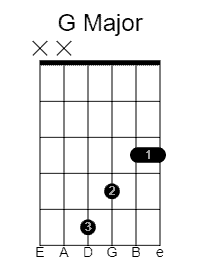
These chords are great because you’ll have the root note on the high e (the thinnest string on your guitar).
Therefore, as long as you know what note you’re fretting on that string, you’ll be able to name the chord.
Also, you’ll be working on your barre chord skills on only two strings.
Minor Chords
Minor chords require you to use your index finger to barre one more string, the third one. Again, if you know what note you’re fretting on the first string, you can name the chord you’re playing.
Finally, we’ll see the same three chords: E, F, and G.

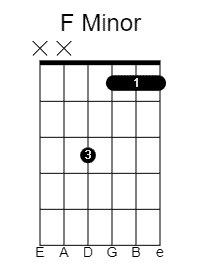
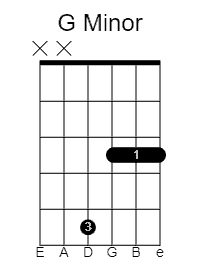
The 7th Chords
Finally, we made it to the third shape. Here, you’ll be required to add one more string to your barre chord skills using the index finger to play strings 1, 2, 3, and 4.
Again, we’ll use E, F, and G to demonstrate it. Remember, as long as you know what note you’re fretting on the first string, you’ll be able to name the chord.
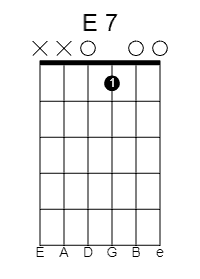
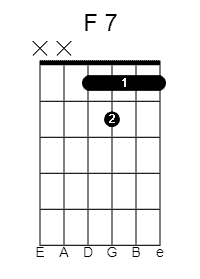

The Based-on-D Alternative
Let’s take a look at another alternative that doesn’t require any use of the barre chord technique. These are shapes based on our well-known D chord shape.
We’re going to go through the major, minor, and 7th chords in D, E, and F. The root note in every case will be our 4th string.
The Major Chords
We’re starting with a very well-known open chord: D. As you know, the root note for the D chord is the open fourth string. Hence, as we move to E and F, we’ll move that root note as well.
Finally, as you move these shapes further down the neck, you’ll be able to name the chord as long as you can name the note you’re fretting on that 4th string.



The Minor Chords
The minor chords will follow the same principles above but with a different shape.
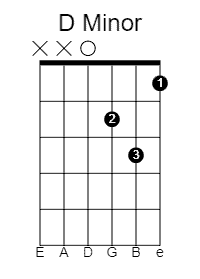

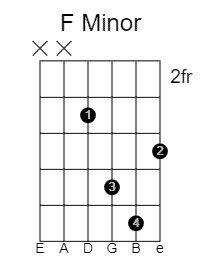
The Seventh Chords
Finally, these seventh chords will also follow the same criteria as above.
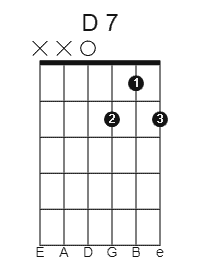


These chord shapes based on the D chord will help you avoid barre chords but can be a tad difficult if you don’t have a big hand because there’s quite a lot of stretching to do.
Nevertheless, with practice and dedication, they can be mastered just like anything else on the guitar.
Is it Wise to Avoid Barre Chords?
I know that deep in your heart, you want me to write that it is wise to avoid them.
Yet, I’m sorry to break your heart: avoiding barre chords is only making it longer to learn them.
You’ll have to eventually learn barre chords to be a better guitar player.
Except, of course, if you’re only playing certain music styles in which you can replace bar chords with 5ths or power chords.
As I said before, these types of chords follow the same idea of the root note moving around the fretboard but utilizing only the top strings of the guitar.
Some great examples of these kinds of music styles are punk rock, grunge, metal, thrash, and most of their derivatives.
Nevertheless, even Johnny Ramone, perhaps punk rock’s most iconic guitar player of all time, played barre chords for most of his utterly successful career.
Barre Chords Get Easier With Time
I know I broke your heart with the last heading but now I want to mend that because barre chords do get easier with time.
Yes, the more you play them, the more you practice them, and the more you work on them, the more effortless they will become.
Furthermore, I promise (based on my own experience) that one day you’ll choose to play barre chords over other, more difficult shapes.
In the same vein, you’ll play barre chords so much that you’ll have to use alternative shapes to make room for more dynamics in your playing.
How Long Will it Take to Master Barre Chords?
Barre chords can’t be thought of as an island. Indeed, guitar playing is a holistic endeavor in which everything is connected.
I know this sounds like Buddhism, but believe me, it has a very logical explanation.
The explanation is in your hands. You’re working your fine motor skills while playing and building strength in your hand’s muscles.
Yes, you wouldn’t expect to lift the same weight Arnold Schwarzenegger does on your first day at the gym, right?
Well, the same thing happens with your hands; you have to work your way there.
So, the perfect answer to that question is: depends on how many hours of playing time you accumulate.
It is not about how much time has gone by since you started playing them but about how much effort you put into it.
Moreover, whenever you’re playing anything on the guitar, even if it’s not barre chords, you’ll still be getting closer to mastering them.
Remember, it’s all in your hands.
The Bottom Line
Playing power chords (or 5ths) is the most common alternative to playing barre chords.
Yet, they have a reduced range of possibilities because you can’t turn them into seventh or minor chords.
The alternatives above are an easier way to play all three most important chord shapes (major, minor, and seventh) without mastering barre chords.
Try them, use them, play them, play with them, and slowly incorporate them into your playing.
Then, when the time comes and barre chords are natural to you, they can become another color in your palette to enhance your playing dynamics.
Happy playing and may the force be with you!

Hello there, my name is Ramiro and I’ve been playing guitar for almost 20 years. I’m obsessed with everything gear-related and I thought it might be worth sharing it. From guitars, pedals, amps, and synths to studio gear and production tips, I hope you find what I post here useful, and I’ll try my best to keep it entertaining also.


